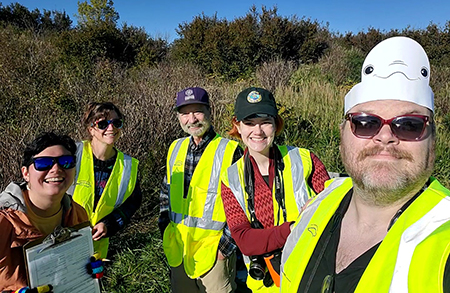Alaska Fish & Wildlife News
October 2024
Belugas Count! 2024

Spotting a bright white beluga whale in the murky waters of Cook Inlet isn’t as simple as it may sound. Seeing one of these iconic whales takes some dedication, so a little help from experts goes a long way.
On a beautiful sunny Saturday in late September, residents and visitors came together throughout Cook Inlet to celebrate the annual Belugas Count! citizen science event. This free family-friendly celebration, hosted by NOAA Fisheries and dozens of partners, is Alaska’s largest one-day marine mammal educational event. Belugas Count! is aimed at raising awareness of the plight of this special whale, which is found only in Cook Inlet, and sharing how the public—local, national, and internationally—can support its recovery.
Beluga whales live in Arctic and subarctic waters in the Northern Hemisphere. Cook Inlet is home to a population of beluga whales that spend their entire lives in Cook Inlet and are geographically and genetically isolated from other populations of belugas in Alaska waters. Once a valuable part of the regional Alaska Native subsistence diet, the Cook Inlet beluga population has declined by 75% since 1979—from about 1,300 whales to around 331 today. Following the rapid decline in abundance during the 1980s and 1990s, the federal government designated the Cook Inlet beluga population as depleted under the Marine Mammal Protection Act (MMPA) in 2002 and endangered under the Endangered Species Act (ESA) in 2008.
Every September, thousands of Alaska residents and visitors gather along the shores of Cook Inlet, joining numerous marine mammal experts from government agencies, universities, non-profit organizations, tribes, industry, zoos, and aquaria across the country to look for, count, and learn about the endangered Cook Inlet beluga whale. Viewing stations throughout Cook Inlet are staffed by beluga experts from 10am – 1pm. Visitors can stop by any of the stations to talk to experts and look for belugas passing by. During this year’s event, 88 belugas were spotted at nine of the 13 viewing stations. This total likely includes recounts of the same whales as they traveled up and down Turnagain Arm past different stations and is not considered an absolute number of belugas seen during the event.

In the afternoon, a free celebration is held at the at the Alaska Zoo with interactive educational activities for kids and adults. Booths from conservation partners and science talks from beluga experts are held all afternoon from 1 – 4pm. Belugas Count! occurs annually in September. To keep up to date on the latest event information, follow the official Belugas Count! Facebook page.
Missed the event this year? Have no fear, there are many ways to get involved with Cook Inlet beluga whale conservation efforts all year round.
Alaska Beluga Monitoring Program
Become a volunteer citizen scientist with the Alaska Beluga Monitoring Program and join NOAA biologists and partners in monitoring beluga presence and behavior each spring and fall. As a volunteer, you’ll acquire knowledge about these animals and their conservation needs, participate in field monitoring, and contribute to collecting scientific data on beluga habitat use. Becoming an AKBMP community scientist is an excellent way to support Cook Inlet beluga whale conservation, all while enjoying your local ecosystem!
Cook Inlet Beluga Whale Photo ID Project

Report your sightings of live Cook Inlet beluga whales to the Cook Inlet Beluga Whale Photo ID Project. The project conducts research and education that contributes to the recovery and conservation of beluga whales in Cook Inlet and provides information to help manage human activities that might affect belugas. Over time, sighting histories are compiled for each known individual and researchers can learn more about the distribution, habitat use, social structure and reproduction of the Cook Inlet beluga whales.
Report Strandings
Report live and dead stranded beluga whales to the Alaska Statewide 24-hour Stranding Hotline: 877-925-7773. Add this number in your phone now so you have it when needed. The most important information to collect is the date, location of stranding (including latitude and longitude), number of animals, and species. Take pictures from different angles if you are able. Please don't move or touch the animal.
Boat Consciously
Practice beluga-friendly boat-operating practices in Cook Inlet waters:
- Scan for belugas and assume they may be present, even if they're not visible.
- Reduce boat speed to 5 knots or less in lower reaches or rivers and mouths during key beluga feeding times.
If you encounter beluga whales
- Delay launching your boat until they leave the area.
- Keep at least 300 feet away at all times.
- Steer clear of their path and go into neutral as safety allows.
- Allow them to pass by your vessel before you proceed to navigate rivers.

Learn more about responsible marine mammal viewing practices on the Alaska Marine Mammal Viewing Guidelines and Regulations page.
Pilot Program
Local pilots flying in Cook Inlet can take this online training to become a Cook Inlet Beluga Reporter. Learn about the value of public stranding reports and the regulations regarding safe aircraft and operation around marine mammals. The first 500 individuals to complete the 10-minute training and quiz will receive a commemorative flight suit patch from ADF&G.
Subscribe to be notified about new issues
Receive a monthly notice about new issues and articles.
